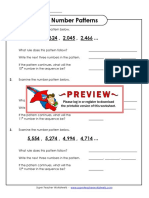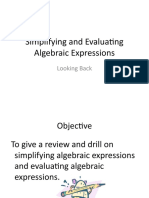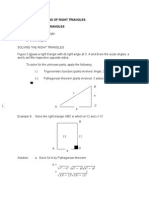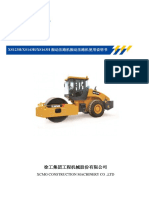0 ratings0% found this document useful (0 votes)
105 views04 Activity Chi Square
04 Activity Chi Square
Uploaded by
Ralph JustineThe document contains two chi-square goodness of fit tests. The first test examines survey results from shoppers at five different department stores to see if the proportion of shoppers is the same across all stores. The chi-square test statistic is above the critical value, so the null hypothesis that the proportions are the same is rejected. The second test examines the results of rolling a six-sided die 240 times to see if the die is unbiased. In this case, the chi-square test statistic is below the critical value, so there is not enough evidence to reject the null hypothesis that the die is unbiased.
Copyright:
© All Rights Reserved
Available Formats
Download as DOCX, PDF, TXT or read online from Scribd
04 Activity Chi Square
04 Activity Chi Square
Uploaded by
Ralph Justine0 ratings0% found this document useful (0 votes)
105 views2 pagesThe document contains two chi-square goodness of fit tests. The first test examines survey results from shoppers at five different department stores to see if the proportion of shoppers is the same across all stores. The chi-square test statistic is above the critical value, so the null hypothesis that the proportions are the same is rejected. The second test examines the results of rolling a six-sided die 240 times to see if the die is unbiased. In this case, the chi-square test statistic is below the critical value, so there is not enough evidence to reject the null hypothesis that the die is unbiased.
Copyright
© © All Rights Reserved
Available Formats
DOCX, PDF, TXT or read online from Scribd
Share this document
Did you find this document useful?
Is this content inappropriate?
The document contains two chi-square goodness of fit tests. The first test examines survey results from shoppers at five different department stores to see if the proportion of shoppers is the same across all stores. The chi-square test statistic is above the critical value, so the null hypothesis that the proportions are the same is rejected. The second test examines the results of rolling a six-sided die 240 times to see if the die is unbiased. In this case, the chi-square test statistic is below the critical value, so there is not enough evidence to reject the null hypothesis that the die is unbiased.
Copyright:
© All Rights Reserved
Available Formats
Download as DOCX, PDF, TXT or read online from Scribd
Download as docx, pdf, or txt
0 ratings0% found this document useful (0 votes)
105 views2 pages04 Activity Chi Square
04 Activity Chi Square
Uploaded by
Ralph JustineThe document contains two chi-square goodness of fit tests. The first test examines survey results from shoppers at five different department stores to see if the proportion of shoppers is the same across all stores. The chi-square test statistic is above the critical value, so the null hypothesis that the proportions are the same is rejected. The second test examines the results of rolling a six-sided die 240 times to see if the die is unbiased. In this case, the chi-square test statistic is below the critical value, so there is not enough evidence to reject the null hypothesis that the die is unbiased.
Copyright:
© All Rights Reserved
Available Formats
Download as DOCX, PDF, TXT or read online from Scribd
Download as docx, pdf, or txt
You are on page 1of 2
1. A department store, A, has four competitors: B, C, D, and E.
Store A hires a consultant to determine if the percentage of
shoppers who prefer each of the five (5) stores is the same. A
survey with 1100 randomly selected shoppers is conducted,
and below are the results of which one of the store's shoppers
prefer. Is there enough evidence using a significance level 𝛼 =
0.05 to conclude that the proportions are really the same?
Store A B C D E
Number of Shoppers 262 234 204 190 210
a. The null hypothesis 𝐻0: The population frequencies are equal
to the expected frequencies.
b. The alternative hypothesis 𝐻𝑎: The null hypothesis is false.
c. The level of significance 𝛼 = 0.05
d. The degrees of freedom: k – 1 = 5 -1 = 4
e. The test statistic:
(O- (O−E) 2
STORE E=r*c/N O (O-E) 2 E
E)
A 1100 / 5 = 220 262 42 1764 8.018
B 1100 / 5 = 220 234 14 196 .891
C 1100 / 5 = 220 204 -16 256 1.164
D 1100 / 5 = 220 190 -30 900 4.091
E 1100 / 5 = 220 210 -10 100 .455
2
x =¿14.169
f. The critical value: a = 0.05 and k – 1 = 4, critical value = 9.49
g. Decision: x 2 = 14.619 > 9.49, there is enough evidence to reject
the null hypothesis.
2. Suppose that we have a 6-sided die. We assume that the die is
unbiased (upon rolling the die, each outcome is equally likely).
An experiment is conducted in which the die is rolled 240
times. The outcomes are in the table below. At a significance
level of 𝛼 = 0.05, is there enough evidence to support the
hypothesis that the die is unbiased?
Outcome 1 2 3 4 5 6
Frequency 34 44 30 46 51 35
a. The null hypothesis 𝐻0: Every roll of the die is likely equal.
b. The alternative hypothesis 𝐻𝑎: The null hypothesis is false.
c. The level of significance 𝛼 = 0.05
d. The degrees of freedom: k – 1 = 6 – 1 = 5
e. The test statistic:
(O−E) 2
SIDES E=r*c/N O (O-E) (O-E)2 E
1 240 / 6 = 40 34 -6 36 0.9
2 240 / 6 = 40 44 4 16 0.4
3 240 / 6 = 40 30 -10 100 2.5
4 240 / 6 = 40 46 6 36 0.9
5 240 / 6 = 40 51 11 121 3.025
6 240 / 6 = 40 35 -5 25 0.625
x=¿ 8.35
f. The critical value: a = 0.05 and k – 1 = 5, critical value is 11.07
g. Decision: x 2 = 8.35 < 11.07, there is not enough evidence to
reject the null hypothesis and the die is unbiased.
You might also like
- BBM2102 Introduction To Purchasing and SuppliesDocument5 pagesBBM2102 Introduction To Purchasing and Suppliescyrus100% (1)
- ABAP List Viewer (ALV) ReportsDocument34 pagesABAP List Viewer (ALV) ReportsSUDHARSANA SNo ratings yet
- Lecture 4 - Cellular CommunicationDocument53 pagesLecture 4 - Cellular CommunicationTanveer Ahmed Hakro100% (1)
- Sum and Differences IdentitiesDocument2 pagesSum and Differences IdentitiesAlonnah Marie RoblesNo ratings yet
- Part B Hypothesis Testing and Confidence IntervalsDocument10 pagesPart B Hypothesis Testing and Confidence IntervalsSiful Islam Fahad100% (1)
- 04 Activity 2 MMWDocument2 pages04 Activity 2 MMWAbbegail Calinao100% (2)
- Pletser - Lagrangian and Hamiltonian Analytical Mechanics PDFDocument138 pagesPletser - Lagrangian and Hamiltonian Analytical Mechanics PDFcibercafejava100% (3)
- Chi Square Calculation MethodDocument10 pagesChi Square Calculation Methodananthakumar100% (1)
- Module 1Document4 pagesModule 1GeeklyGamer 02No ratings yet
- ANOVADocument41 pagesANOVAstranded sinceNo ratings yet
- Regression Correlation ActivityDocument2 pagesRegression Correlation ActivityXiaoyu KensameNo ratings yet
- Chapter 6 Binomial CoefficientsDocument21 pagesChapter 6 Binomial CoefficientsArash RastiNo ratings yet
- Number Theory: Bachelor of Secondary EducationDocument1 pageNumber Theory: Bachelor of Secondary EducationRea Mariz JordanNo ratings yet
- Republic of The Philippines Salvacion, Daraga, Albay A.Y. 2020 - 2021Document3 pagesRepublic of The Philippines Salvacion, Daraga, Albay A.Y. 2020 - 2021Joan May de LumenNo ratings yet
- Depedpang 1Document127 pagesDepedpang 1Bayoyong NhsNo ratings yet
- 1.0 Syllabus (Sample Only) Course Name Trigonometry Course Credit Course Description Contact Hours/week Prerequisite Course OutcomesDocument24 pages1.0 Syllabus (Sample Only) Course Name Trigonometry Course Credit Course Description Contact Hours/week Prerequisite Course OutcomesAngelica Banad SorianoNo ratings yet
- Modular Arithmetic Youtube Lecture HandoutsDocument10 pagesModular Arithmetic Youtube Lecture HandoutshadhaiNo ratings yet
- Mathematical Induction PDFDocument6 pagesMathematical Induction PDFGAEA FAYE MORTERANo ratings yet
- Linear Algebra AssignmentDocument11 pagesLinear Algebra AssignmentLim Yan HongNo ratings yet
- Solve Right Triangles PowerPointDocument13 pagesSolve Right Triangles PowerPointKatherine LeeNo ratings yet
- Wealth CreationDocument11 pagesWealth CreationvipulNo ratings yet
- Unit 1: Measures of Central Tendency: Module 6: Descriptive Statistical MeasuresDocument10 pagesUnit 1: Measures of Central Tendency: Module 6: Descriptive Statistical MeasuresABAGAEL CACHONo ratings yet
- 10 - 1 Simplifying Rational Expressions Trout 09Document14 pages10 - 1 Simplifying Rational Expressions Trout 09Vehid KurtićNo ratings yet
- Practice Test On MatricesDocument10 pagesPractice Test On MatricesowaisNo ratings yet
- Mathm109-Calculus II - Module 6Document5 pagesMathm109-Calculus II - Module 6richard galagNo ratings yet
- Mathm109-Calculus II - Module 5Document13 pagesMathm109-Calculus II - Module 5richard galagNo ratings yet
- Elimination Matching ActivityDocument2 pagesElimination Matching ActivityVictoria SchererNo ratings yet
- Trig Exam 2 Review F07Document6 pagesTrig Exam 2 Review F07Rodion Romanovich RaskolnikovNo ratings yet
- Vectors, Linear Combinations and Linear IndependenceDocument13 pagesVectors, Linear Combinations and Linear Independenceray hajjarNo ratings yet
- L6-L7-Matrices For Linear TransformationsDocument32 pagesL6-L7-Matrices For Linear TransformationsHarshini MNo ratings yet
- Problem Solving Mathematics - Lesson 1Document27 pagesProblem Solving Mathematics - Lesson 1Nishinoya KenNo ratings yet
- Math 131 - Action Research in Mathematics EducationDocument9 pagesMath 131 - Action Research in Mathematics EducationAngel Guillermo Jr.No ratings yet
- College AlgebraDocument30 pagesCollege AlgebraGelvie LagosNo ratings yet
- Business Plan Ladaran (Autosaved)Document12 pagesBusiness Plan Ladaran (Autosaved)Charles SalinasNo ratings yet
- 5 Linear Transformation of MatricesDocument53 pages5 Linear Transformation of Matricesalienxx100% (1)
- TRIG FUNCTIONS Lesson Solving Right TrianglesDocument52 pagesTRIG FUNCTIONS Lesson Solving Right TrianglesRudi BerlianNo ratings yet
- Advanced Algebra MODULE Week 1-2Document247 pagesAdvanced Algebra MODULE Week 1-2Jun Dl CrzNo ratings yet
- TMIGLesson 1Document5 pagesTMIGLesson 1Marie ShaneNo ratings yet
- Sampling Distribution and Point Estimation of Parameters: MATH30-6 Probability and StatisticsDocument24 pagesSampling Distribution and Point Estimation of Parameters: MATH30-6 Probability and StatisticsmisakaNo ratings yet
- 8.1 Worksheet Polar CoordinatesDocument3 pages8.1 Worksheet Polar CoordinatesRonnieMaeMaullionNo ratings yet
- 2.3 Relation and FunctionDocument41 pages2.3 Relation and FunctionAlma G. FloridaNo ratings yet
- Parametric Equations and Polar CoordinatesDocument112 pagesParametric Equations and Polar CoordinatesZazliana IzattiNo ratings yet
- 2.2 Hyphothesis Testing (Continuous)Document35 pages2.2 Hyphothesis Testing (Continuous)NS-Clean by SSCNo ratings yet
- Chinese Remainder TheoremDocument7 pagesChinese Remainder TheoremManohar NVNo ratings yet
- 33 Simplified Radical FormDocument11 pages33 Simplified Radical FormJepot PascualNo ratings yet
- Quiz - MIDTERM EXAM-PROBLEM SOLVING PDFDocument2 pagesQuiz - MIDTERM EXAM-PROBLEM SOLVING PDFkava keefeNo ratings yet
- Lesson One Introduction To Inferential StatisticsDocument20 pagesLesson One Introduction To Inferential Statisticssai raoNo ratings yet
- Mean Median Mode Grouped Data.Document21 pagesMean Median Mode Grouped Data.John Carl YomeroNo ratings yet
- Methods of Teaching MathematicsDocument11 pagesMethods of Teaching Mathematicsqulb abbasNo ratings yet
- Mathematical LanguageDocument12 pagesMathematical LanguageNicaa NiloNo ratings yet
- Module 1 Advancedstat PDFDocument5 pagesModule 1 Advancedstat PDFGerry MakilanNo ratings yet
- Number Patterns: Super Teacher WorksheetsDocument2 pagesNumber Patterns: Super Teacher WorksheetsPeiEnOngNo ratings yet
- Test StatisticDocument17 pagesTest StatistictrishaNo ratings yet
- Prime FactorizationDocument21 pagesPrime Factorizationaftapci2023No ratings yet
- Module Requirement For Abstract AlgebraDocument6 pagesModule Requirement For Abstract AlgebraNimrod CabreraNo ratings yet
- Demo Algebraic ExpressionDocument23 pagesDemo Algebraic ExpressionJhenard Pelle100% (1)
- Problem FormulationDocument20 pagesProblem FormulationPurple ShinesNo ratings yet
- Simplifying and Evaluating Algebraic Expressions: Looking BackDocument27 pagesSimplifying and Evaluating Algebraic Expressions: Looking BackthebtcircleNo ratings yet
- Module 2 MMWDocument28 pagesModule 2 MMWJAN HENRYCK RODRIGUEZNo ratings yet
- Lesson 3.0 Solutions of Right Triangles 3.1 Solving Right TrianglesDocument25 pagesLesson 3.0 Solutions of Right Triangles 3.1 Solving Right TrianglesJo HarNo ratings yet
- Circular Functions WorksheetDocument1 pageCircular Functions WorksheetHNo ratings yet
- Real Number SystemDocument32 pagesReal Number SystemJoy MendozaNo ratings yet
- The Population Frequencies Are Equal To The Expected Frequencies. The Null Hypothesis Is FalseDocument3 pagesThe Population Frequencies Are Equal To The Expected Frequencies. The Null Hypothesis Is FalseAbbegail CalinaoNo ratings yet
- Chi_Square_Test_with_ProblemDocument1 pageChi_Square_Test_with_Problemopaorobert1006No ratings yet
- 02 Task Performance 1ARGDocument3 pages02 Task Performance 1ARGRalph JustineNo ratings yet
- Homework Deductive ReasoningDocument1 pageHomework Deductive ReasoningRalph JustineNo ratings yet
- Homework Activity 2Document2 pagesHomework Activity 2Ralph JustineNo ratings yet
- 03 Task Performance 1 - ARGDocument2 pages03 Task Performance 1 - ARGRalph JustineNo ratings yet
- 02 Task Performance 1ARGDocument3 pages02 Task Performance 1ARGRalph JustineNo ratings yet
- 01 ELMS Activity 1 (CAÑAL)Document1 page01 ELMS Activity 1 (CAÑAL)Ralph JustineNo ratings yet
- As530 300617 0236 74Document514 pagesAs530 300617 0236 74komal.kothariNo ratings yet
- 1st Edition Yumiko Higuchi: Visit To Download The Full and Correct Content DocumentDocument53 pages1st Edition Yumiko Higuchi: Visit To Download The Full and Correct Content DocumentlezahxinyuNo ratings yet
- Climate ChangeDocument12 pagesClimate ChangeManthar RathoreNo ratings yet
- Computer ArchitectureDocument16 pagesComputer ArchitectureJerika Marie Valdez MartinezNo ratings yet
- Math 443/543 Graph Theory Notes 5: Digraphs, Tra C, and TournamentsDocument3 pagesMath 443/543 Graph Theory Notes 5: Digraphs, Tra C, and TournamentsshubhamNo ratings yet
- External Pressure Calculation ResultsDocument8 pagesExternal Pressure Calculation ResultsAndika DearsonNo ratings yet
- L36GSI: VGF Series Gas EngineDocument2 pagesL36GSI: VGF Series Gas EngineferyNo ratings yet
- Busn 179 Individual ProposalDocument11 pagesBusn 179 Individual Proposalapi-553118940No ratings yet
- Pso2 DxdiagDocument10 pagesPso2 DxdiaglunarsaleNo ratings yet
- Drugs Anti TBDocument2 pagesDrugs Anti TBLeo_Rabacca_3610No ratings yet
- Chemistry Hydrogen and Its CompoundsDocument57 pagesChemistry Hydrogen and Its CompoundsYogesh Dongre100% (3)
- MultiSIM BLUE - Getting StartedDocument6 pagesMultiSIM BLUE - Getting StartedMaximus MaxisNo ratings yet
- Aelp 1Document139 pagesAelp 1R.keerthi. ReddyNo ratings yet
- Bcacctg2 - Accounting For Partnership and Corporation: Exercise 4 Shareholders' EquityDocument4 pagesBcacctg2 - Accounting For Partnership and Corporation: Exercise 4 Shareholders' EquityNimfa SantiagoNo ratings yet
- EMC - Handout - Week 1 - AC - 2020-2021Document52 pagesEMC - Handout - Week 1 - AC - 2020-2021set_hitNo ratings yet
- Steve McEwen Agent BrochureDocument41 pagesSteve McEwen Agent BrochureSteve McEwen100% (1)
- Self Learning Material Grade 11 EnglishDocument70 pagesSelf Learning Material Grade 11 EnglishJamunanantha PranavanNo ratings yet
- Monash University Problem Based Learning: A New Way of Studying BusinessDocument4 pagesMonash University Problem Based Learning: A New Way of Studying BusinessMonash UniversityNo ratings yet
- W540 FRU List MT 20BG, 20BH: Fru PN CRU ID DescriptionDocument11 pagesW540 FRU List MT 20BG, 20BH: Fru PN CRU ID DescriptionEverson DantasNo ratings yet
- pc11504 c1 19 01apr13 1136dcyDocument1,136 pagespc11504 c1 19 01apr13 1136dcyCarlos A Martimes100% (2)
- XS123H振动压路机说明书中英文Document118 pagesXS123H振动压路机说明书中英文nitesh100% (3)
- Principles of Hygiene & SanitationDocument115 pagesPrinciples of Hygiene & SanitationMark Jayson Y. VillanuevaNo ratings yet
- 2 Stroke Diesel Engine Components-1Document72 pages2 Stroke Diesel Engine Components-1Edem0% (1)
- Odelya EN 10217-5 SAW Steel Tubes For Pressure PurposesDocument1 pageOdelya EN 10217-5 SAW Steel Tubes For Pressure PurposesSaid AssalehNo ratings yet
- Adhesive Capsulitis: Braddom's ClassificationDocument2 pagesAdhesive Capsulitis: Braddom's ClassificationJJ DdNo ratings yet
- Worksheet 02 PDFDocument3 pagesWorksheet 02 PDFVijay BhaskarNo ratings yet































































































